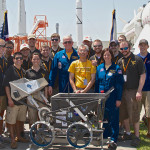
The fourth time proved to be the charm for the robotics team from West Virginia University in NASA’s 2014 Robotic Mining Competition. The team, made up of students from the Statler College of Engineering and Mineral Resources and Air Force ROTC Detachment 915, took top honors in both the mining and outreach portions of the competition, which is held annually at Florida’s Kennedy Space Center.
“We went down to the competition with the mindset that we were going to win it,” said team leader Tim Godisart, from Waynesburg, Pennsylvania. “We were actually better prepared this year and had a more experienced team.”
Godisart should know; he’s been on the team each of the past four years, first as an undergraduate and now as a graduate student in electrical engineering. “I stayed involved because I wanted to win,” he said. “We’ve come so close every year. And the learning experience is fantastic. Being involved in a project like this is a wonderful opportunity to bridge the gap between what you learn in the classroom and its real world application.”
Godisart and his teammates spent “40-plus hours a week” on top of classes to build the robot, which is designed to traverse a simulated Martian terrain. The robot must excavate Martian regolith, a sand-like material, and deposit it into a collector bin within 10 minutes.
“This year’s design was an optimization of last year’s robot,” said Godisart. “While the design basically remained the same we made the frame better and cut its weight down by 10 kilos.”
And unlike many of their competitors, the WVU team fabricated every single part that went into its robot.
“We don’t have access to a machine shop in electrical engineering to machine our parts,” said Godisart. “Everything that was used in our robot was student built.” He noted that the team was grateful to colleagues in the College’s Department of Chemical Engineering, which allowed them to access to their machine shop around the clock.
On day one of the competition, the team dealt with some minor communication issues between the robot and the computer used to operate it. “We did dig more than anybody else on our first run, but we were disappointed because we knew we could have done better,” said first-year team member Larry Reaves, a native of Morgantown, who is working toward his master’s degree in computer science. “We spent nearly 2.5 minutes idle during the 10-minute run due to communications issues.” Despite that, WVU still managed to mine 101.5 kilos of regolith, tops for the day.
Going into day two, the team knew exactly what it needed to do to win. “After last year’s performance, we knew we could pull out a victory with the right mix of weight and autonomous operations,” said Alexander Hypes, a mechanical engineering major from Lewisburg.
“We knew we had to get 1,117 points to come out on top,” said aerospace engineering major Barrett Dietzius, a three-year member of team from Woodbridge, Virginia. “We tested the idea of a fully autonomous run, which means the robot does everything on its own, which would have earned us more points. Instead, we decided to go partially autonomous, with manual intervention toward the end because we knew we were capable of mining even more regolith than we did the first day.”
The plan worked, with WVU mining 121.1 kilos of regolith, which put them on top by six points. In recognition of their win, the team was awarded a $3,000 scholarship as well as an invitation to attend a future launch at the Kennedy Space Center.
The team also earned a $500 scholarship for capturing top honors for its outreach program, which promoted STEM – science, technology, engineering and mathematics –activities in area schools.
“Our team partnered with Technology Education for Kids, an after-school enrichment program that provides elementary- and middle-school aged students with the tools and support necessary to learn to analyze and create solutions to real-world challenges,” said Powsiri Klinkhachorn, professor of computer science and electrical engineering, who serves as the team’s faculty adviser. “Our students volunteered two hours per week over six weeks to assist students in Mountain View, Cheat Lake and North elementary schools to build a growbot, a robot designed to monitor and care for a small garden or plant.”
The team also assisted with WVU’s Society of Women Engineer’s Girl Scouts Day, Monongalia County’s Eighth Grade Career Day and visited a number of area schools to introduce robotics to students throughout the region.
“Starting only two weeks after returning from the 2013 competition, the team reached out to and mentored more than 4,000 students throughout the year,” said Klinkhachorn. “This accomplishment was made possible due to the experiences, relationships and contacts made during the previous year’s competition.”
While Klinkhachorn is “incredibly proud” of this year’s team, which also included mechanical engineering major Adam Blakeman, from Charleston; computer and electrical engineering major John Lucas, from New Market, Maryland; and electrical engineering master’s candidate Matt Grubb, from Winchester, Virginia, there is still a lot of work ahead.
Klinkhachorn will be assisting WVU students at two more robotics competitions in early June: NASA’s Robo-Ops Competition, held at Houston’s Johnson Space Center’s Rock Yard and the NASA and Worcester Polytechnic Institute Sample Return Robot Challenge, which will be held in Worcester, Massachusetts.
WVU’s Robotic Mining Competition team was sponsored by the Statler College, the Lane Department of Computer Science and Electrical Engineering, the Department of Mechanical and Aerospace Engineering, the NASA West Virginia Space Grant Consortium and Air Force ROTC Detachment 915.